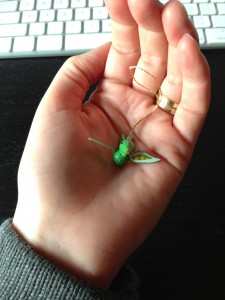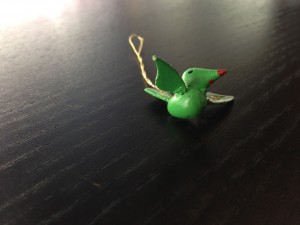By Brooke Borel | January 16, 2013 | 7 Comments

Discarded Christmas dreams in Brooklyn. I mean trees. Discarded trees.
In early January, the sidewalks in my neighborhood are lined with discarded Christmas trees. It?s the collective holiday hangover trash, and quite frankly it makes me sad; the trees mark the moment of winter where all that is left are several cheerless months of cold and drudgery. My dog, however, goes apeshit over them. He loves to sniff them. He loves to pee on them. And, a couple of weeks ago, his Christmas tree habit led me to some unexpected psychological self-analysis.

Lorenzo peeing on discarded tree. No one looked at me funny when I took this picture. JK, everyone did!
On an early walk, as my dog lifted his leg on the eighth tree of the morning, I saw a tiny ornament clinging to its lowest branches. It was a green bird about the size of my thumbnail with black eyes, a small dot of red paint under its beak that looked almost like a smile, and yellow and white patterns running down its outstretched wings. Despite the smile, the bird looked so sad, forgotten there in the trash pile.
My first thought: ?Oh, no no no. You don?t deserve this.? And I bent down, pulled it off of the branch, and cradled it in the palm of my hand.
My second thought: ?I will save you.? And I zipped it into my coat pocket.
My next thought: ?What the hell was that?? I?d just picked up trash from a dirty Brooklyn sidewalk and put it in my pocket. Worse: if my dog likes peeing on those trees, I?d bet the other dogs in the neighborhood do, too, which made it a probable urine-soaked piece of trash. Still, I couldn?t bring myself to throw it away.
When I got home, I did what any procrastinating science writer with a pile of deadlines would do: I put everything aside to try to figure out why I felt empathy for a piece of trash.

Reenactment of cradling bird ornament in hand. So tiny. So fragile.
I had a hunch that my attraction to Freddie (yes, by this time my trash had a name) had to do with the fact that he (and a gender) was shaped like an?animal. If the ornament had been a ball or a star, I doubt I would have even noticed it. After a fair amount of Googling embarrassingly unscientific phrases like ?why we prefer animal shaped objects? and ?why we like things with faces,? the closest work I could find was by Northwestern University psychologist Adam Waytz, who studies, in part, the psychology of anthropomorphism, or why?we imbue objects or non-human animals with?human-like characteristics, motivations, and emotions. Or, as Waytz describes it: ?Giving a mind to a non-human entity.?
According to Waytz, there are three reasons why people give such agency to everything from technology to gods to bird-shaped Christmas ornaments.
The first is that when we see something that resembles a human, perhaps in how it looks or moves, we tend to treat it like a human. Even minimal cues, such as the presence of eyes, can prompt this psychological response.
The second is the motivation to understand the behavior of something by making it familiar. For humans, the most familiar object is, well, a human, which means we may try to understand general behavior in human terms, like deciding the car is in a bad mood when it won?t start in the morning or assuming the dog is getting us back for something when he misbehaves.
The third is the motivation for social connection, particularly for those who lack that connection with people. We?re social creatures, and making friends with objects or animals may be a coping mechanism for loneliness.
In my case, Waytz suspects that the first reason applies most (you could also argue for number three, as I?m a freelancer who faces hours of solitude each day, but let?s not. I have real friends, I swear!). I was seeing Freddie as human-like, which led to my feelings of empathy. Now, a bird is not a human, and a tiny wooden bird is further from it, but Freddie does have eyes and a mouth. Once I saw these features and aligned them with humanness, anthropomorphism manifested as me seeing the ornament as ?a moral patient that has a right not to be harmed,? says Waytz. The bird had a right not to be thrown away, which made me want to rescue it. Its tiny size may have helped, Waytz adds, as we especially charge small animals or objects with emotion.

Freddie on my desk. Note the eyes and little smile. Is this why I rescued him? Perhaps.
The moral part is important, adds Waytz: ?Why this all matters at all and why we started studying this odd phenomenon of seeing human things in non-human states is because anthropomorphism has implications for morality.? He and his colleagues are currently exploring the opposite case of dehumanization, where people treat other people as either animals or objects as in cases of torture or abuse. They are also looking at the downstream consequences of humanizing an object. One might be that by thinking an object has a mind of its own, you make it capable of judging you.
Freddie has been on my desk ever since I brought him home and he isn?t going anywhere other than on my own Christmas tree later this year. Perhaps I fear the bird?s judgment, or that tossing him would reflect badly on my own morals. Or, maybe I?ve just grown to like him.
So, dear LWON readers, a question for you: have you ever had a similar experience with an inanimate object? If so, what were the circumstances and where is that object now?
**
Brooke Borel is a science writer in Brooklyn, New York. She is currently writing a book about bed bugs for the University of Chicago Press (2014). Find more of her work at www.brookeborel.com or follow her on Twitter @brookeborel.
Image Credits:
All photos by Brooke Borel
Sources/additional reading:
Interview with Adam Waytz, Northwestern University
Epley et al, ?On Seeing Human: A Three-Factor Theory of Anthropomorphism,? Psychological Review 114:4 864-886 (2007)
Epley et al, ?Creating Social Connection Through Inferential Reproduction,? Psychological Science 19:2 114-120 (2008)
Waytz et al, ?Social Cognition Unbound: Insights Into Anthropomorphism and Dehumanization,? Current Directions in Psychological Science 19(1) 58-62 (2010)
Comments
student loan forgiveness ufc 145 weigh ins record store day 2012 detroit red wings jose canseco zimmerman derek fisher
কোন মন্তব্য নেই:
একটি মন্তব্য পোস্ট করুন